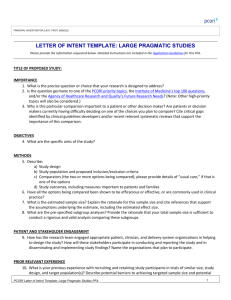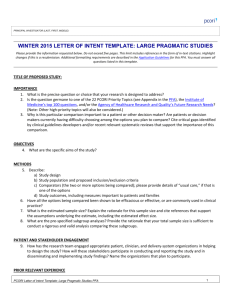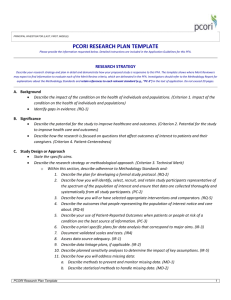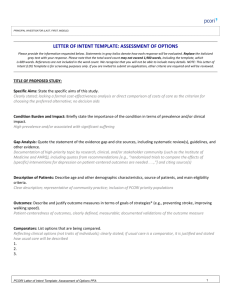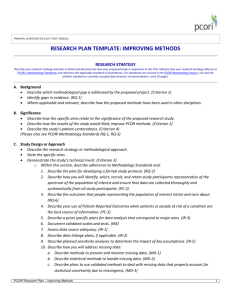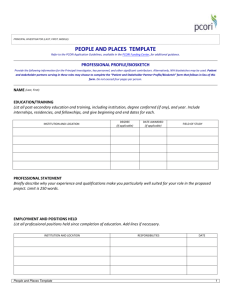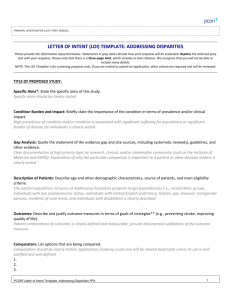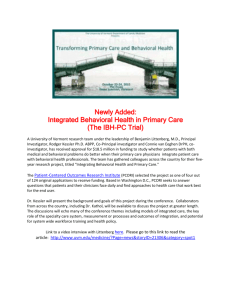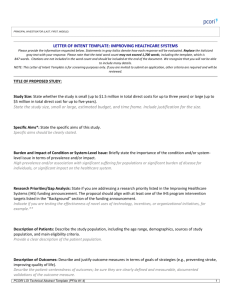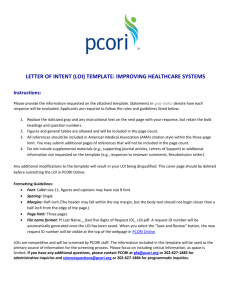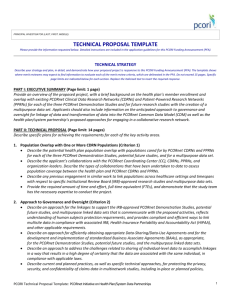Research
advertisement
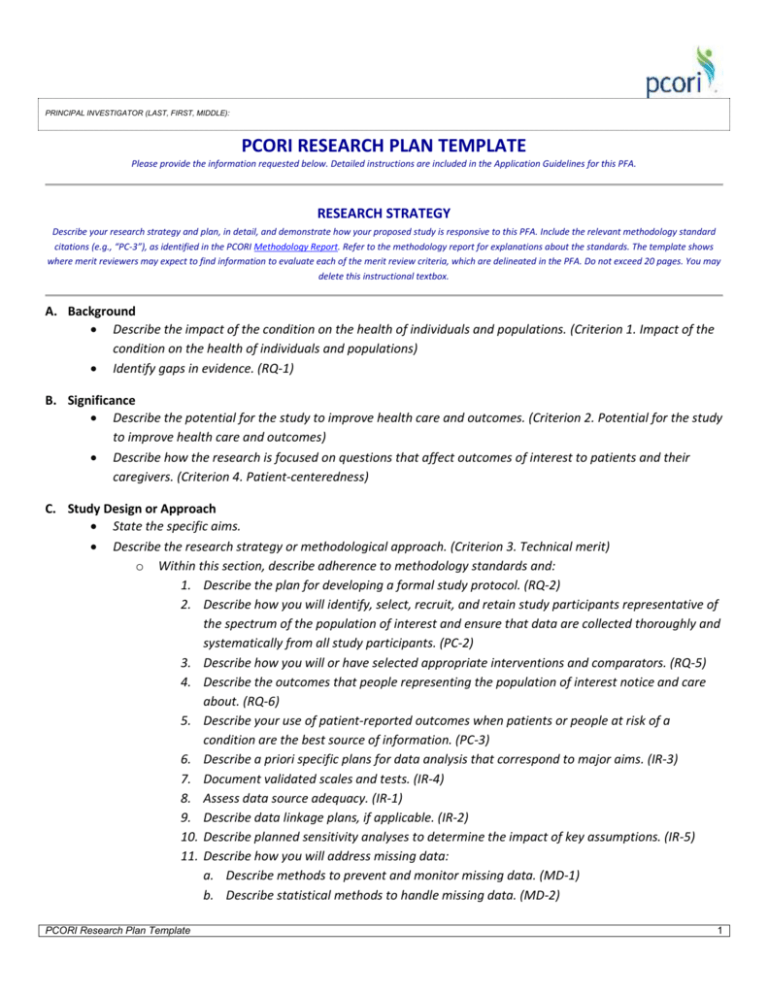
PRINCIPAL INVESTIGATOR (LAST, FIRST, MIDDLE): PCORI RESEARCH PLAN TEMPLATE Please provide the information requested below. Detailed instructions are included in the Application Guidelines for this PFA. RESEARCH STRATEGY Describe your research strategy and plan, in detail, and demonstrate how your proposed study is responsive to this PFA. Include the relevant methodology standard citations (e.g., “PC-3”), as identified in the PCORI Methodology Report. Refer to the methodology report for explanations about the standards. The template shows where merit reviewers may expect to find information to evaluate each of the merit review criteria, which are delineated in the PFA. Do not exceed 20 pages. You may delete this instructional textbox. A. Background Describe the impact of the condition on the health of individuals and populations. (Criterion 1. Impact of the condition on the health of individuals and populations) Identify gaps in evidence. (RQ-1) B. Significance Describe the potential for the study to improve health care and outcomes. (Criterion 2. Potential for the study to improve health care and outcomes) Describe how the research is focused on questions that affect outcomes of interest to patients and their caregivers. (Criterion 4. Patient-centeredness) C. Study Design or Approach State the specific aims. Describe the research strategy or methodological approach. (Criterion 3. Technical merit) o Within this section, describe adherence to methodology standards and: 1. Describe the plan for developing a formal study protocol. (RQ-2) 2. Describe how you will identify, select, recruit, and retain study participants representative of the spectrum of the population of interest and ensure that data are collected thoroughly and systematically from all study participants. (PC-2) 3. Describe how you will or have selected appropriate interventions and comparators. (RQ-5) 4. Describe the outcomes that people representing the population of interest notice and care about. (RQ-6) 5. Describe your use of patient-reported outcomes when patients or people at risk of a condition are the best source of information. (PC-3) 6. Describe a priori specific plans for data analysis that correspond to major aims. (IR-3) 7. Document validated scales and tests. (IR-4) 8. Assess data source adequacy. (IR-1) 9. Describe data linkage plans, if applicable. (IR-2) 10. Describe planned sensitivity analyses to determine the impact of key assumptions. (IR-5) 11. Describe how you will address missing data: a. Describe methods to prevent and monitor missing data. (MD-1) b. Describe statistical methods to handle missing data. (MD-2) PCORI Research Plan Template 1 PRINCIPAL INVESTIGATOR (LAST, FIRST, MIDDLE): c. Describe plans to use validated methods to deal with missing data that properly account for statistical uncertainty due to missingness. (MD-3) d. Describe how you will record and report all reasons for dropout and missing data, and account for all patients in reports. (MD-4) e. Describe how you will examine sensitivity of inferences to missing data methods and assumptions, and incorporate these into interpretation. (MD-5) 12. Describe how you will address heterogeneity of treatment effect (HTE): a. State the goals of any planned HTE analyses. (HT-1) b. For all HTE analyses, pre-specify the analysis plan; for hypotheses-driven HTE analyses, pre-specify hypothesis and supporting evidence base. (HT-2) c. Describe the basis for all HTE claims based on appropriate statistical contrasts among groups being compared, such as interaction tests or estimates of differences in treatment effect. (HT-3) d. For any HTE analysis, describe the plan to report all pre-specified analyses and, at minimum, the number of post hoc analyses, including all subgroups and outcomes analyzed. (HT-4) 13. Describe your reporting plan—provide sufficient information in reports to allow for assessments of the study’s internal and external validity (IR-6) For nonrandomized studies, describe how you will address causal inference standards CI-1 to CI-6. For patient-centered outcomes research (PCOR) data registry, describe how you will address standards DR1A to DR-1H, DR-2, and DR-3. For PCOR data network, describe how you will address standards DN-1A to DN-1G, and DN-2. For adaptive and Bayesian trial designs, describe how you will address standards AT-1 to AT-5. For diagnostic tests, describe how you will address standards DT-1 to DT-5. For systematic review, describe how you will address standard SR-1. For randomized clinical trials, which are not addressed in the methodology standards, cite currently accepted best practices to which you plan to adhere. D. Project Milestones and Timeline Describe the projected outcomes and clearly articulate the goals to be accomplished during the research study. Refer to Appendix 1: Example Milestones included in the Application Guidelines, for assistance as you complete this section. Provide a timeline (see table below) for completion of the research project within the proposed project duration. List each milestone and projected completion date, including the following, as appropriate: o IRB approval o Minutes of DSMB meetings o Start of recruitment (indicate target total) o Completion of 25 percent of recruitment o Completion of 50 percent of recruitment o Completion of 75 percent of recruitment o Completion of recruitment PCORI Research Plan Template 2 PRINCIPAL INVESTIGATOR (LAST, FIRST, MIDDLE): o o o o o o o o o o o Focus group results Questionnaire/tool Final study protocol Interim analyses Final analyses Data sets, analytic data sets, and codebook Interim progress reports due every 6 months Final report due on the last day of the contract period Copies of submitted and published manuscripts Registration of the trial on clinicaltrials.gov Engagement updates, every 6 months, noting specific engagement activities that patients/stakeholders participated in during the reporting time period. Examples of engagement activities include describing or summarizing the specific ways in which patient and stakeholders were involved in the development of interventions materials, and describing patient and stakeholder involvement and contribution in the early stages of the research project, such as enrollment of research participants, baseline assessments, and the process evaluation component. Project Timeline (Add additional rows as needed) Project Activity Expected Completion Date Year 1 Year 2 Year 3 PCORI Research Plan Template 3 PRINCIPAL INVESTIGATOR (LAST, FIRST, MIDDLE): E. Patient Population Describe the study population with respect to numbers of participants, age, gender, race, ethnicity, and clinical status as appropriate for the study. Identify specific populations (with respect to age, gender, race, ethnicity, and clinical status as appropriate) and health decision(s) affected by the research. (RQ-3) Identify and assess participant subgroups. (RQ-4) Describe the source from which patients will be recruited, including the volume of eligible patients available and expected participation rate. Discuss how barriers to recruitment will be overcome. Complete the tables below: Recruitment Plan Total number of study participants expected to be screened: Total number of study participants expected to be eligible of those screened: Target sample size (use same number stated in milestones): Estimated Final Racial/Ethnic and Gender Enrollment Table Race Male (N) American Indian/Alaska Native Asian Black/African American Hawaiian/Pacific Islander White Multirace Ethnicity Male (N) Female (N) Total (N) Female (N) Total (N) Hispanic (Latino/Latina) Non-Hispanic F. Research Team and Environment Describe the capabilities of the research team to accomplish the goals of the proposed research project, and the appropriateness of the research environment to conduct the study. Describe how and why the study sites were selected (e.g., the representativeness of the selected sites out of all potential study sites, the populations served and how it will provide a representative patient sample, and how the study sites provide real-world settings for implementing the study). Note: Please provide all key personnel professional and partner profiles/biosketches and detailed site descriptions within the People and Places Template as a separate PDF upload. G. Engagement Plan Describe the plan to engage patients and stakeholders meaningfully in the various phases of the proposed research. (Criterion 5. Patient and stakeholder engagement) (Please also see PCORI Methodology Standard PC-1.) Refer to the PCORI Research Plan Template 4 PRINCIPAL INVESTIGATOR (LAST, FIRST, MIDDLE): Engagement Rubric: Guidance for Completing the Engagement Plan, included in the Application Guidelines’ Appendix 2, for assistance as you complete this plan. Each numbered section below corresponds to a numbered section in the rubric. 1. PLANNING THE STUDY: Describe how patient and stakeholder partners will participate in study planning and design. (Enter your information here.) 2. CONDUCTING THE STUDY: Describe how patient and stakeholder partners will participate in the study conduct. (Enter your information here.) 3. DISSEMINATING THE STUDY RESULTS: Describe how patient and stakeholder partners will be involved in plans to disseminate study findings and to ensure that findings are communicated in understandable, usable ways. (Enter your information here.) 4. PRINCIPLES FOR ENGAGEMENT Reciprocal Relationships: Describe the roles and decision-making authority of all research partners, including patient and stakeholder partners. (Enter your information here.) Co-learning: Describe plans to ensure that patient and stakeholder partners will understand the research process and that researchers will understand patient and stakeholder engagement and patient-centeredness. (Enter your information here.) Partnership: Describe how the time and contributions of patient partners are valued and demonstrated in fair financial compensation, as well as reasonable and thoughtful time commitment requests. (Enter your information here.) Trust, Transparency, Honesty: Describe how major decisions are made inclusively and information is shared readily with all research partners, including patient and stakeholder partners; how patient and stakeholder partners and research partners express commitment to open and honest communication with one another; and how the study team commits to communicate study findings to the community studied, in a meaningful and usable way. (Enter your information here.) PCORI Research Plan Template 5 PRINCIPAL INVESTIGATOR (LAST, FIRST, MIDDLE): DISSEMINATION AND IMPLEMENTATION POTENTIAL For detailed instructions, refer to the Application Guidelines for your PFA. Do not exceed two pages. A. Describe the potential for disseminating and implementing the results of this research in other settings. (Please also see PCORI Methodology Standard PC-4.) B. Describe possible barriers to disseminating and implementing the results of this research in other settings. C. Describe how you will make study results available to study participants after you complete your analyses. PCORI Research Plan Template 6 PRINCIPAL INVESTIGATOR (LAST, FIRST, MIDDLE): REPLICATION AND REPRODUCIBILITY OF RESEARCH AND DATA SHARING For detailed instructions, refer to the Application Guidelines for your PFA. Do not exceed two pages. A. Describe the ability to reproduce potentially important findings from this research in other data sets and populations. B. Describe how you will make available, within 9 months of the end of the final year of funding, a complete, cleaned, de-identified copy of the final data set used in conducting the final analyses, or your data-sharing plan, including the method by which you will make this data set available, if requested. C. Propose a budget to cover costs of your data-sharing plan, if requested. These costs do not need to be included within the Budget Template. PCORI Research Plan Template 7 PRINCIPAL INVESTIGATOR (LAST, FIRST, MIDDLE): PROTECTION OF HUMAN SUBJECTS For additional guidance, refer to Section 5.0, “Human Subjects Research Policy,” of the Supplemental Grant Application Instructions for All Competing Applications and Progress Reports, from the U.S. Department of Health and Human Services. For detailed instructions, refer to the Application Guidelines for your PFA. Do not exceed five pages. Describe the protection of human subjects who will be involved in your research. PCORI Research Plan Template 8 PRINCIPAL INVESTIGATOR (LAST, FIRST, MIDDLE): CONSORTIUM CONTRACTUAL ARRANGEMENTS For detailed instructions, refer to the Application Guidelines for your PFA. Do not exceed five pages. Describe the proposed research projects that will be performed by subcontracted organizations. Explain the strengths that these partners bring to the overall project. PCORI Research Plan Template 9 PRINCIPAL INVESTIGATOR (LAST, FIRST, MIDDLE): REFERENCES CITED For detailed instructions, refer to the Application Guidelines for your PFA. Do not exceed 10 pages. Following scholarly citation practice, list the source material cited in this Research Plan. PCORI Research Plan Template 10 PRINCIPAL INVESTIGATOR (LAST, FIRST, MIDDLE): APPENDIX (optional) For detailed instructions, refer to the Application Guidelines for your PFA. Do not exceed 10 pages. PCORI Research Plan Template 11
